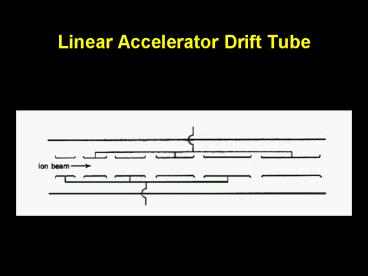Linear Accelerator Drift Tube - PowerPoint PPT Presentation
1 / 24
Title:
Linear Accelerator Drift Tube
Description:
Linear Accelerator Drift Tube Simple X-ray Tube Nuclear Fission Fisson/Reactor Products Cyclotron Products Generally decay by b- emission because of excess neutrons ... – PowerPoint PPT presentation
Number of Views:326
Avg rating:3.0/5.0
Title: Linear Accelerator Drift Tube
1
Linear Accelerator Drift Tube
2
Positive Ion Cyclotron Operation
3
CS-15 Positive Ion CyclotronWashington
University School of Medicine
4
Target
5
Targets for Cyclotron
1. Metals 111Cd(p,n)111In (111In-DTPA) 201H
g(d,2n)201Tl (201Tl-chloride)
68Zn(p,2n)67Ga (67Ga-citrate) 2.
Gases 14N(d,n)15O (H215O, 15O2) 14N(p,?)11C
(11C-acetate, 11C- palmitate, 11C-
glucose) 3. Liquids 16O(p,?)13N (13N-ammonia
) 18O(p,n)18F (18F-FDG)
6
Simple X-ray Tube
7
- Fast neutrons (E of 1.5 MeV) have a low
probability of interaction with other nuclei. - They are thermalized or slowed down (0.025 eV)
to interact with other nuclei. - Moderators (low MW materials like heavy water,
beryllium or graphite) are distributed - in spaces between fuel rods
8
University of Missouri Research Reactor
(MURR) Columbia, MO
9
(No Transcript)
10
Nuclear Fission
235U144 n
236U144
236U144
144Ba88 89Kr53 3n
99Mo42 135Sn50 2n
- 236U unstable - undergoes fission immediately
- wide range of fission products - usually 1/3 and
2/3 split of the mass number
11
I-131
Mo-99
Fission products useful in nuclear medicine
include 99Mo, 131I, 133Xe, 137Cs and 90Sr
12
Reactor-Produced RadionuclidesThermal Neutron
Reactions
- (n, g) reaction formed by reactions between
targets and thermalized neutrons
YAz n
Y1Az g
Atarget Aisotope produced same atomic number,
different mass
- (n, g) reaction
- not carrier-free, since target and product are
same - radioisotopic purity can be high if cross section
is sufficiently large (e.g. 176Lu(n,g)177Lu)
13
Reactor-Produced RadionuclidesThermal Neutron
Reactions, contd
- (n, p) reaction formed by reactions between
targets and thermalized neutrons
YAz n
YBz-1 p
Atarget Bisotope produced different atomic
number, same mass
- (n, p) reaction
- carrier-free, since target and product are
different - example 64Zn(n,p)64Cu
14
Fisson/Reactor Products Cyclotron Products
- Generally decay by b- emission because of excess
neutrons - Not many are useful for diagnostic imaging, but
several are useful for radiotherapy
- Generally decay by b emission or electron
capture because of excess protons - Many are useful for diagnostic imaging
- (gamma scintigraphy or positron emission
tomography)
15
(No Transcript)
16
(No Transcript)
17
(No Transcript)
18
Alpen, E.L. (1998) Radiation Biophysics Academic
Press, San Diego, p. 87
19
Alpen, E.L. (1998) Radiation Biophysics Academic
Press, San Diego, p. 105
20
Hall, E.J. (1994) Radiobiology for the
Radiologist J.B. Lippincott Company,
Philadelphia, p. 154
21
Latorre Travis, E. (1989) Primer of Medical
Radiobiology Year Book Medical Publishers,
Inc., Chicago, p. 92
22
RBE
LET
Hall, E.J. (1994) Radiobiology for the
Radiologist J.B. Lippincott Company,
Philadelphia, p. 160
23
Hall, E.J. (1994) Radiobiology for the
Radiologist J.B. Lippincott Company,
Philadelphia, p. 160
24
Alpen, E.L. (1998) Radiation Biophysics Academic
Press, San Diego, p. 52

